A supply chain is only as effective as the coordination between different stakeholders.
When every player in the supply chain works seamlessly together, it provides better visibility and ensures an uninterrupted flow of goods – but achieving this synchronicity can be tricky. To get every stakeholder, process, and tool to function cohesively, you’ll need to master the art of supply chain integration.
In this guide, we’ll explore what supply chain integration entails, what types of integrations you should expect, and some key strategies for successful supply chain integration.
What is supply chain integration?
Supply chain integration is the process of unifying all the functions and activities within your supply chain.
Supply chain integration enhances visibility and streamlines various activities, from procurement and logistics to production and multichannel distribution. When these supply chain processes are integrated, it allows the seamless flow of goods and information to increase supply chain efficiency.
Key components of an integrated supply chain
Supply chain integration is a multifaceted process that can vary from business to business. That said, there are three essential aspects to integrating your supply chain that every brand must tackle:
- Centralized communication: In an integrated supply chain, stakeholders communicate with each other through a single platform or through a standardized format so that everyone (even third-party vendors) is clear on what is expected of them. This helps to reduce delays and miscommunications that could disrupt your supply chain operations, and stay informed on possible delays and disruptions.
- Integrated technology: A truly integrated supply chain requires you to maintain a centralized supply chain management (SCM) system that integrates seamlessly with other supply chain technology and vendor tools. This allows each department to access the information they need when they need it, and the real-time transfer of information through these technology integrations also ensures that each team gets the most up-to-date information, minimizing the risk of errors.
- Coordination between key supply chain players: For your supply chain processes to fully integrate, it’s important to work closely with all the key players in your supply chain network. This includes everyone from your suppliers and manufacturers to your wholesale distributors and logistics partners. Proper coordination between key supply chain players allows everyone to fulfill their responsibilities effectively and reduces the risk of delays and bottlenecks.
Types of supply chain integration
There are two main types of supply chain integration: vertical integration and horizontal integration.
Vertical integration
A vertical integration is when a business integrates with other companies at different stages of the supply chain, such as suppliers, manufacturers, distributors, and logistics providers.
If you visualize the supply chain as a cascading series of supply chain stages (with procurement and sourcing at the top and last-mile delivery at the bottom), vertical integration involves a business taking ownership of the supply chain stages above and below them, that both precede and follow a sale.
This allows brands to cut out middlemen, giving them better control over their operations while also achieving cost savings. For instance, a clothing brand may acquire a business that manufactures fabric, which allows them to maintain better control over the quality of materials. They may also save money in the long run, as they no longer have to pay upcharges on raw materials.
A brand may also choose to bring downstream supply chain functions like fulfillment or retail distribution in-house, though this requires significant time, capital investment, and expertise to be effective.
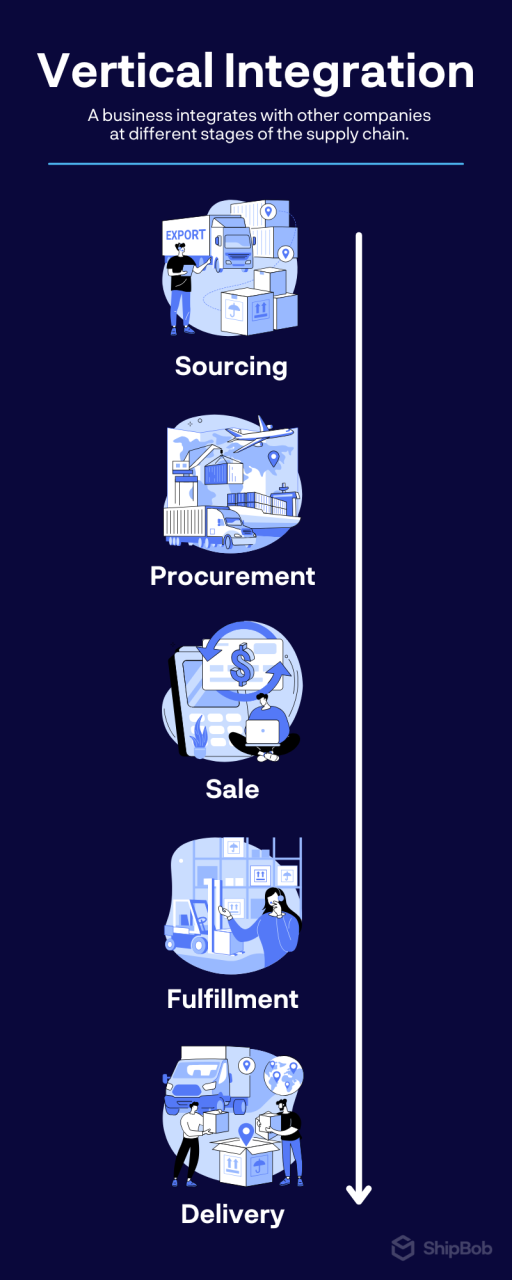
Horizontal integration
Horizontal integration involves ecommerce brands integrating with other businesses at the same lateral stage of the supply chain, such as competitors and retailers. The integration may involve acquiring or partnering with other businesses, allowing a brand to increase its market share, expand its product range, and tap into new markets to gain a competitive advantage.
For instance, a pet food brand may acquire a company the specializes in pet nutrition so that they can offer quality nutrition products under their brand name. Additionally, they may form partnerships with retail distributors like Chewy and Amazon to reach a wider market.
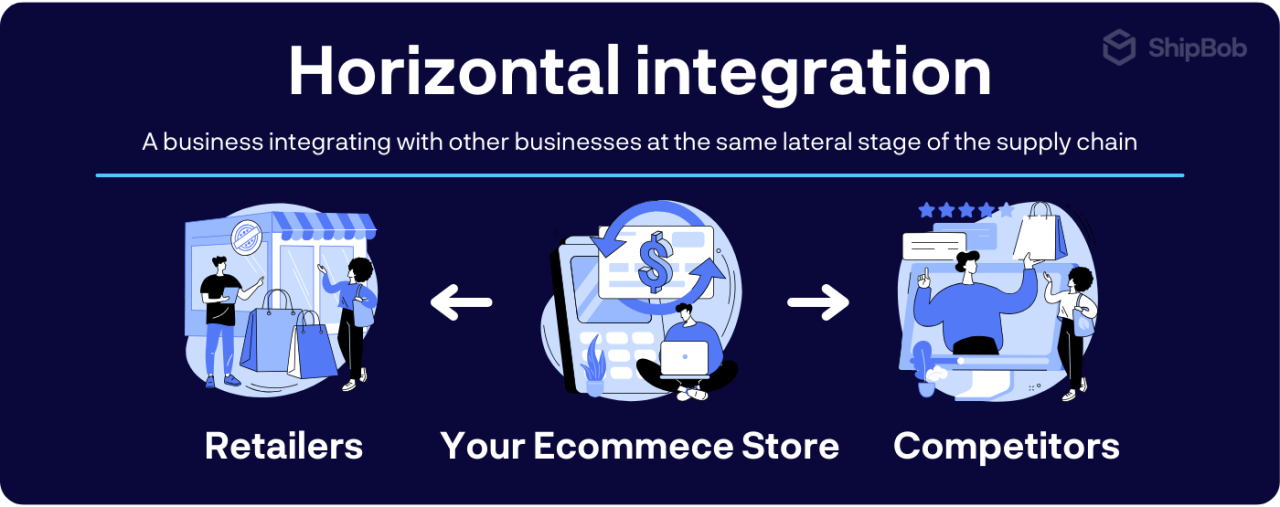
Common supply chain integration challenges
Integrating your supply chain isn’t easy, and brands may face a number of challenges both during and following integration. Here are some of the most common obstacles brands face when integrating their supply chain.
Complexity in coordination and management
With so many moving parts involved in the supply chain, coordinating and managing dozens of functions can be challenging. Businesses need to ensure that their procurement, manufacturing, and shipping processes work together effortlessly toward a common goal; but if there are technology limitations and outdated processes, this is easier said than done.
To streamline the integration process, make sure you and other stakeholders working with modern technology across the board. Additionally, consider conducting a supply chain audit to identify tedious or manual processes that could be optimized or automated.
Resistance to change
Businesses may also experience internal resistance when integrating their supply chains. Many teams and stakeholders may find it difficult to move away from legacy systems and existing business processes, since employees are already well-acquainted with them.
As such, it’s important to properly train your team and equip them with the skills and knowledge needed for implementing your new integration initiatives. Change management is also essential to ensure a smooth transition from existing processes to integrated processes.
Cost and resource allocation
Cost is one of the biggest hurdles when integrating your supply chain. You may discover that your supply chain needs a complete overhaul, or that you need to invest in technology that can better integrate with other supply chain tools. There’s also the direct and indirect costs associated with retraining staff and getting them acquainted with new processes, vendors, and tools.
The best way to prevent costs from spiraling out of control is to take a gradual approach to supply chain integration over time, and transitioning in carefully budgeted phases. This minimizes the financial strain while also giving your team more time to familiarize themselves with your new integrated processes.
Benefits of supply chain integration
Given all these challenges, many ecommerce brands ask themselves if an integrated supply chain is worth it – but there are huge advantages to supply chain integration. Here are some of the best benefits that come from adopting an integrated supply chain strategy.
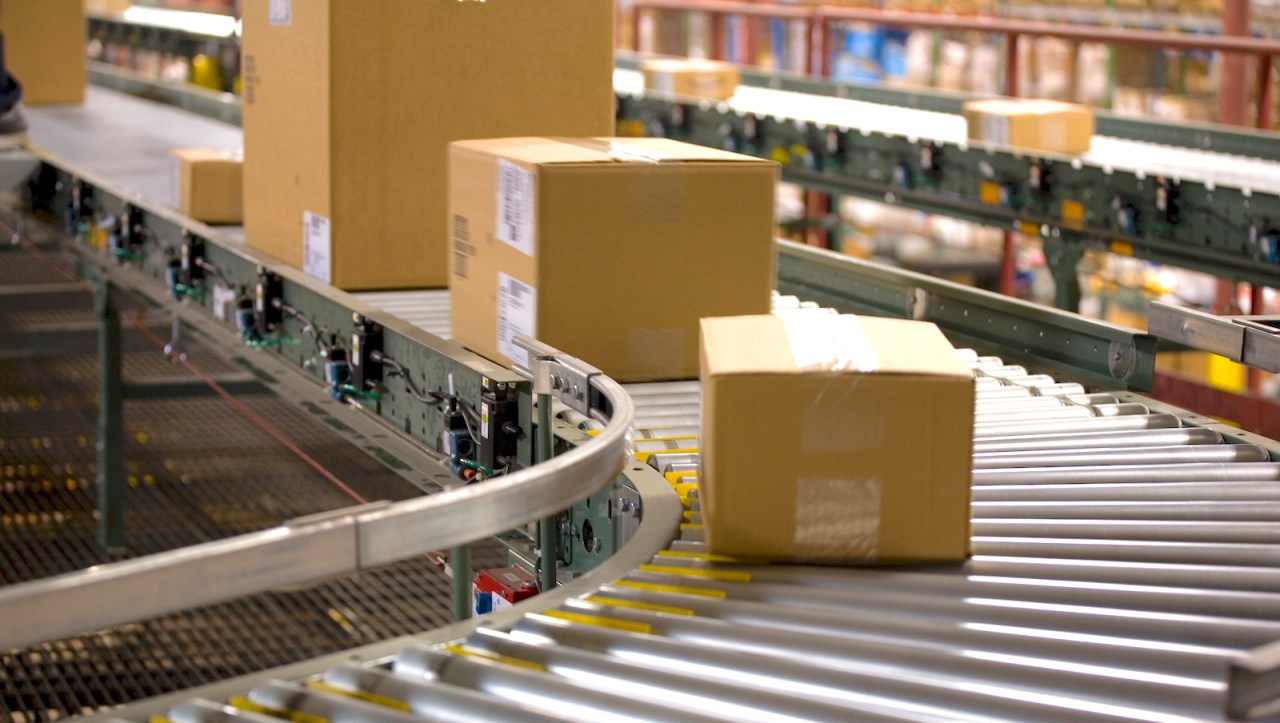
Amplified efficiency and productivity
The enhanced visibility and improved communication involved in an integrated supply chain allow you to streamline your operations and reduce redundancies. This makes it easier to optimize your resources so that you can improve your operational efficiency and enhance productivity.

Improved communication and collaboration
Integrated technology systems allow supply chain partners to communicate and collaborate in real time. This makes it easier for teams and third-party providers alike to work together, improving efficiency and relationships between suppliers, manufacturers, and distributors.

Smarter spending and reduced costs
When your supply chain functions are integrated, it helps you reduce waste and minimize transactional costs. When you take ownership of production or logistics, you exponentially lower your inventory costs as you spend less on sourcing and transporting goods. This allows smarter spending and reduces your overall costs, which adds up to maximized profits.

Calculated risk management
An increased supply chain visibility is the key to supply chain resilience. It makes it easier to see what’s going on across the network, which helps you anticipate issues and possible risks before they escalate. This improves supply chain agility as you can take a calculated approach to manage those risks and mitigate them.
How technology powers supply chain integration
In the modern ecommerce landscape, technology underpins any successful supply chain integration, whether it’s vertical or horizontal. Here are just some of the technology solutions involved in supply chain integration for ecommerce businesses, and how they facilitate smoother, more cohesive operations.
Cloud-based solutions streamline collaboration
Cloud-based supply chain solutions allow a seamless flow of information between relevant supply chain partners. This allows different departments to work together effortlessly and collaborate in real time, even from remote locations.
For instance, cloud-based enterprise resource planning (ERP) software allows warehouse teams to update inventory levels in real time. Manufacturing teams can then use this information, along with demand trends, to match their production efforts.
Inventory management systems improve visibility
Ecommerce supply chains can also make use of robust inventory management systems that come with powerful inventory tracking tools to improve visibility across different supply chain stages. These tools ensure that the inventory data is updated in real time to a cloud-based warehouse management system that’s accessible from different locations, so you get an accurate picture of your inventory levels across different warehouses and fulfillment centers.
These inventory management tools are also equipped with powerful analytics features, which keep track of historical sales data and inventory performance to determine demand trends. This helps with accurate demand forecasting so you can plan your production, purchasing, and procurement accordingly.
Automation tools enhance efficiency
Many supply chain tools also let you automate some of your manual tasks and reduce inefficiencies. Supply chain automation can be applied to your time-consuming administrative tasks like demand forecasting and procurement, as well as some aspects of your warehouse and inventory management.
For instance, you can set up automatic reorder point notifications to instantly alert you when you need to place a replenishment order. Additionally, you can use automation tools to optimize your routes and improve your transit times.
4 supply chain integration strategies for success
As we mentioned before, supply chain integration can be tricky. Here are some strategies for building a strong, unified supply chain for your ecommerce brand.

1. Overcome resistance to change
You can’t effectively converge any supply chain activities or stakeholders without buy-in from your team, so take the time to address any internal resistance to change.
In addition to walking your teams through any changes to their daily functions, help employees understand how new technology and processes will positively impact their jobs and make their lives easier.

2. Foster collaboration among partners
If partners can’t or won’t work with each other, then supply chain integration is not possible. Subsequently, make sure to establish open communication and seamless information sharing between internal teams and external vendors or stakeholders to facilitate this collaboration. Encourage an internal culture of transparency and cooperation, and extend this to your supplier relationships as well as your relationships with third-party service providers.
Support these efforts by investing in technology that enables real-time information sharing across your entire supply chain. This will help you build an environment where partners can find the information they need quickly, and actively work together to address challenges.

3. Seek end-to-end visibility and real-time data
When you have a comprehensive view of your entire supply chain, it’s easier to see how to connect different functions and how different departments can work together. End-to-end supply chain visibility helps you make informed decisions on how to lower costs, improve supply chain efficiency, and optimize your overall performance.
For instance, being able to track real-time inventory levels and order data can help you predict your inventory needs, which will inform raw material sourcing for manufacturers. This will help you make timely replenishments and avoid stockouts further down the line.
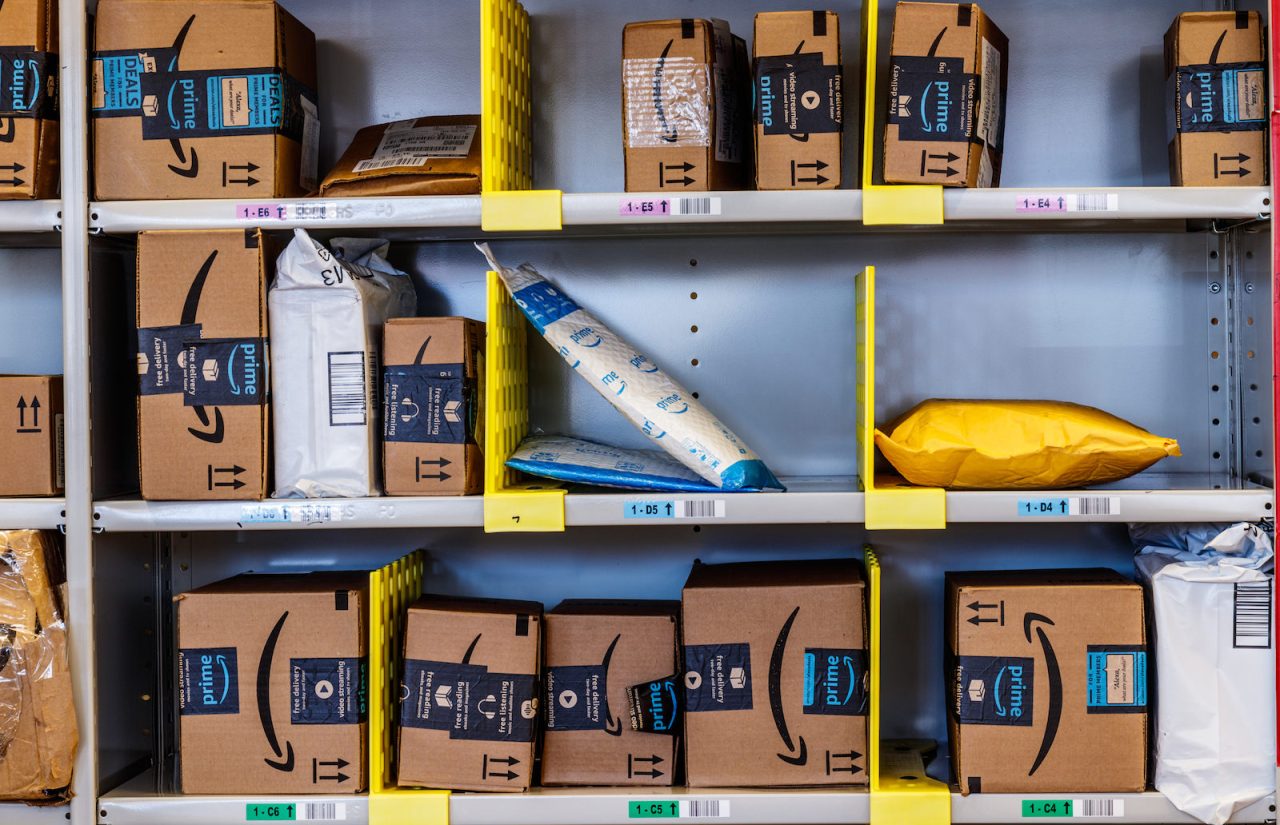
4. Incorporate omnichannel fulfillment
Integrating your supply chain isn’t just about coordinating with vendors and suppliers; it also involves coordinating fulfillment across all your sales channels. It’s important to ensure that, no matter which avenue a customer uses to make a purchase, they experience the same quick and accurate delivery that every other customer gets.
This degree of consistency is extremely difficult to achieve managing fulfillment in-house. For truly integrated multichannel fulfillment, you’ll need to partner with a 3PL or expert logistics partner like ShipBob that’s equipped to connect your various channels through a single platform, and deliver high-quality fulfillment for your DTC, B2B, and marketplace orders.
How ShipBob amplifies ecommerce supply chain success
If you’re looking for a fulfillment partner that will seamlessly integrate with your existing upstream and downstream supply chain, ShipBob can help.
ShipBob’s software and solutions integrate directly with major ecommerce platforms, marketplaces, and tools to help streamline the process of connecting your entire tech stack. Not only that, ShipBob offers capabilities you need to build and maintain a cohesive, efficient supply chain, including freight management, retail distribution and dropshipping, reporting, and more.
Here’s a closer look into just some of the ways ShipBob helps brands unify and optimize their supply chains.
Real-time inventory and order management
ShipBob’s software features built-in inventory management tools, so you can monitor and track your inventory as it moves across your supply chain. Inventory data is updated in real time as orders come in from multiple sales channels and are fulfilled in different fulfillment centers. This ensures that you have the most updated inventory information to help with inventory control and management across your entire supply chain.

Distributed inventory for optimized fulfillment
You can also take advantage of ShipBob’s vast network of fulfillment centers to strategically distribute your inventory without complicating your supply chain further. Leveraging ShipBob’s Inventory Placement Program, brands are able to calculate the most ideal split of inventory across ShipBob’s dozens of fulfillment centers, so you can minimize shipping costs and times and achieve better supply chain efficiency.
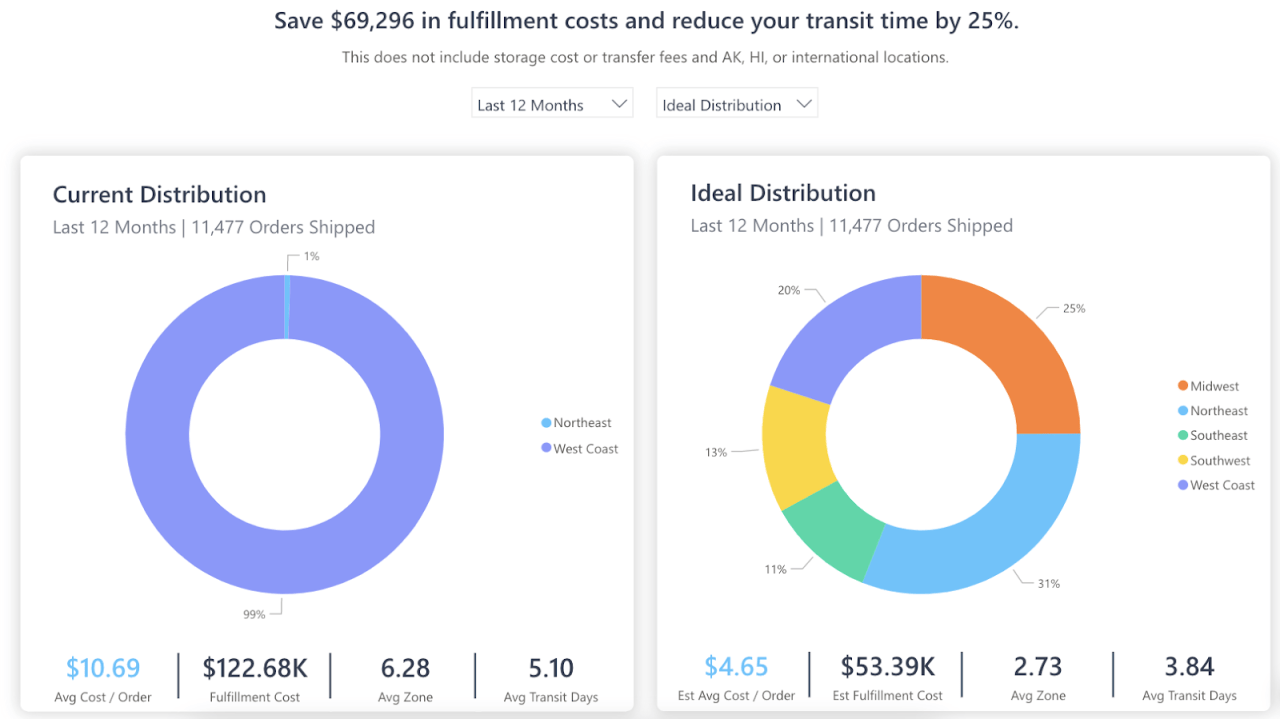
Better yet, ShipBob will take care of physically transporting your inventory to regional fulfillment centers for you. This not only saves you time and effort, but allows your brand reap the benefits of distributed inventory without integrating additional vendors or warehousing providers into your supply chain.
Faster shipping with 2-day express
ShipBob’s 2-day express shipping service helps you deliver faster, shortening your supply chain’s lead time and boosting customer satisfaction. This affordable 2-day shipping solution is powered by a proprietary algorithm that leverages a combination of air, ground, and regional carriers to ensure on-time deliveries, and allows you to deliver in 2 days across the contiguous United States (even from a single fulfillment center).
Integrated return management
Returns are a key part of the supply chain as well. ShipBob offers integrations with leading ecommerce returns management platforms, which allows you to process and manage returns efficiently. ShipBob also enables you to automate certain aspects of the returns process (including taking actions like restocking, quarantining, or disposing of returned items) to further streamline your operations.
Scalable solutions for growing businesses
ShipBob’s solutions are designed to scale with your business, so you can effortlessly expand your supply chain – and your ecommerce brand’s reach. Specifically, ShipBob supports:
- Dozens of integrations with ecommerce platforms and tools
- Omnichannel fulfillment for DTC, B2B, and marketplaces (like Amazon) or social channels (like TikTok)
- Managed freight solutions for brands manufacturing products outside of the US
- Customization capabilities for DTC orders, including gift notes, marketing inserts, and branded packaging
- Flexible fulfillment capacity to manage peak volumes seamlessly
- A proprietary warehouse management system for brands looking to optimize in-house fulfillment
For more information on how ShipBob can help you optimize your brand’s supply chain, click the button below to get in touch.
Supply chain integration FAQs
Below are answers to the most commonly asked questions about supply chain integration.
How does ShipBob help with supply chain integration?
As an expert ecommerce fulfillment partner, ShipBob enables brands to streamline key supply chain functions like receiving, inventory management, order management fulfillment, shipping, and supply chain performance reporting through a single solution. ShipBob also integrates with major ecommerce platforms, marketplaces, and tools to facilitate seamless supply chain integration, and supports fulfillment across multiple sales channels and locations.
How do information systems support supply chain integration?
Information systems ensure a seamless transfer of information between different supply chain stakeholders. This real-time information flow allows for effective collaboration and an integrated supply chain process.
How can small businesses implement supply chain integration strategies effectively?
Small businesses can effectively implement supply chain integration strategies by leveraging technology systems to unify their supply chain functions. Outsourcing some of their key functions to a tech-enabled service provider is also a viable option.
What role does real-time data play in optimizing a supply chain?
Real-time data provides valuable information that helps businesses to identify problem areas, discover improvement opportunities, and anticipate risks. This then allows them to make informed decisions on optimizing their supply chain.



